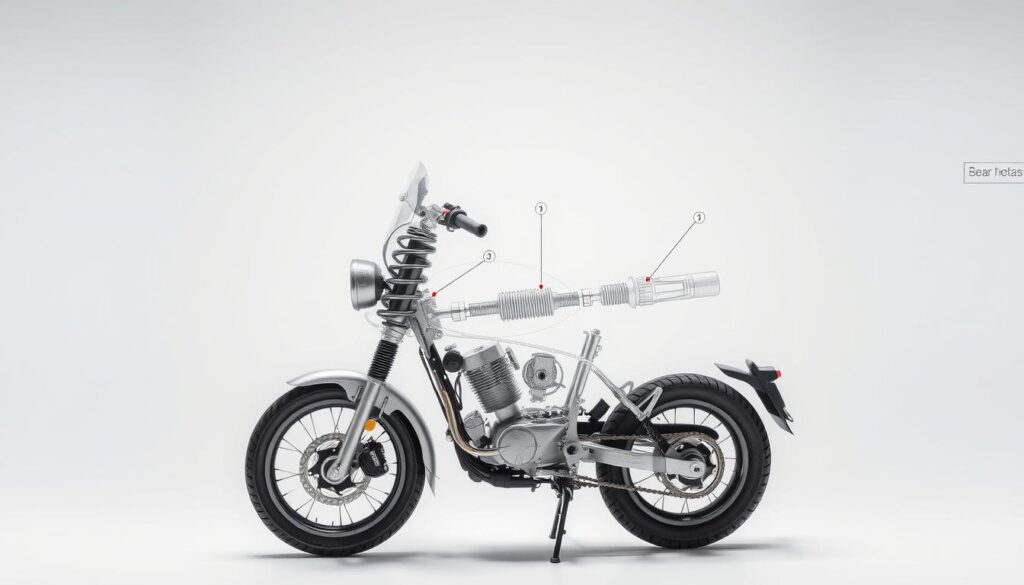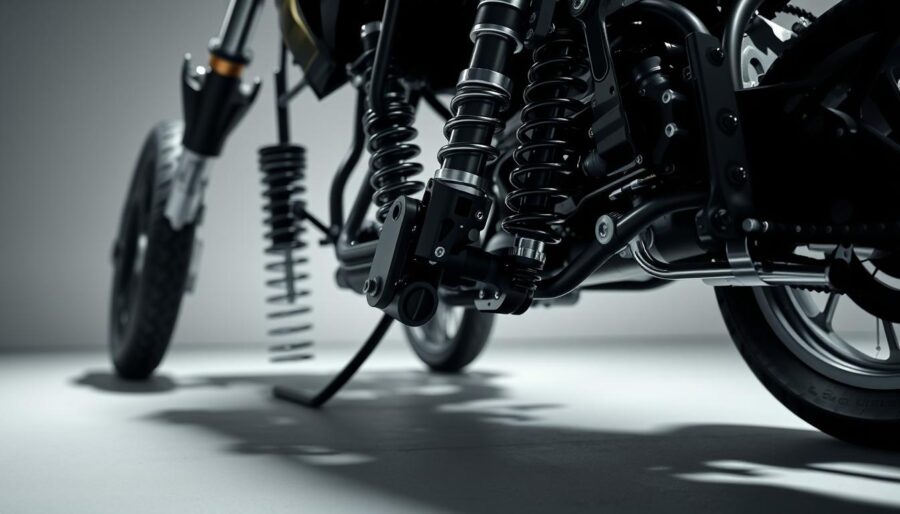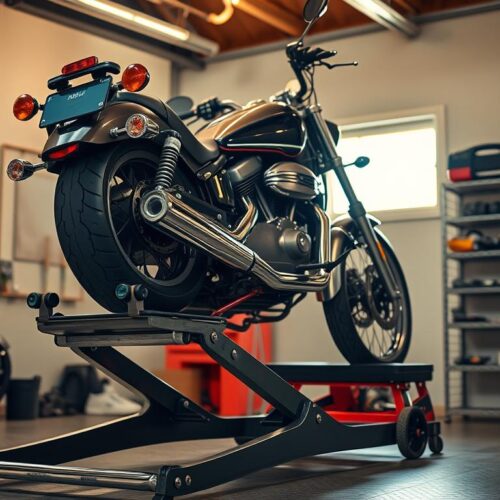Understanding your motorcycle’s suspension setup is key to a great ride. Adjusting the suspension for your weight can improve comfort and handling. It makes sure your wheels work best with the road, giving you control and fun.
In this article, you’ll learn to adjust your motorcycle suspension. It’s for matching your weight and how you ride.
Understanding Motorcycle Suspension Basics
Motorcycle suspension is key to how you enjoy riding. By getting the basics, you can improve both how your ride feels and performs. Looking at suspension preload is a start. It’s about compressing the spring to change how your bike stands and handles bumps. Adjusting this can make your bike handle better.
Damping is also crucial for a good ride. It controls how fast the suspension moves, affecting both stability and comfort. The right damping lets your suspension absorb shocks smoothly, making rough roads feel less bumpy. Mastering these elements helps you set up your suspension for a better ride.
Analyzing Your Body Weight and Riding Style
Your rider weight is super important for your motorcycle’s performance. If you’re heavier, you might need stiffer springs. But if you’re lighter, softer suspension settings could work better for you. Knowing this can really make a difference in both comfort and how well your bike handles.
How you ride also plays a big part in setting up your suspension. If you ride fast and hard, a firmer setup could be better. This helps during quick turns and fast speeds. But if you like cruising smoothly, a softer setup could be more comfortable, especially for longer trips.
It’s crucial to think about both your weight and how you ride your bike. Different motorcycle brands like Harley-Davidson, Yamaha, or Honda give specific advice for the best setup. Following these recommendations can help you get the most out of your ride.
Adjusting Front Suspension
To make your motorcycle ride better, you need to adjust the front suspension. First, measure the fork’s exposed part. You’ll get three key measurements: L1, L2, and L3. These help calculate sag, vital for balance. For sport riding, sag should be between 30mm and 40mm. This makes sure your motorcycle handles well.
After measuring sag, you need to adjust the preload to get the right sag. This means changing the spring tension to adjust suspension length. It affects the bike’s height and stability. Getting the preload right is important. It changes how your motorcycle acts under different conditions.

The front suspension is key to how your bike handles. By adjusting preload based on sag measurements, you make sure your motorcycle is stable and reacts well on all kinds of roads.
Adjusting Rear Suspension
To get the best performance and comfort from your motorcycle, adjust the rear suspension. Start by measuring how far it is from your rear axle to a fixed point on the bike. This helps you figure out the sag, which should be between 25mm and 40mm for most riders, depending on your riding style.
Adjusting the shock preload is key for how your motorcycle feels when you ride it. Adding more preload makes the bike handle better, especially with extra weight. But if you’re lighter, you might need less preload for a smoother ride.
Here’s how to adjust your rear suspension right:
- First, find your static sag by sitting on your bike in your gear.
- See if this number matches the sag you’re aiming for.
- Change the shock preload to get the right weight and style fit.
- Double-check your sag setting after making changes.
Keeping an eye on your rear suspension and tweaking it as needed makes your ride smoother. Learning to adjust the preload and sag means you can set up your motorcycle just how you like it.
| Rider Weight | Shock Preload Setting | Recommended Sag |
|---|---|---|
| Under 150 lbs | Low (1-3 clicks) | 30mm |
| 150-200 lbs | Medium (4-6 clicks) | 35mm |
| Over 200 lbs | High (7+ clicks) | 40mm |
Measuring Sag for Optimal Setup
Measuring sag is key for the best motorcycle suspension setup. It affects how your bike handles and feels. To start, you need to measure your bike without weight (L1) and with your weight (L2).
The sag is found by subtracting L2 from L1. This shows how well your bike carries your weight. Getting this right is crucial for fine-tuning your suspension.
Try to set your sag between 25mm and 40mm, depending on how and where you ride. Road and sport bikes usually need tighter sag. Off-road bikes might need looser sag for better bump handling. The right sag makes your ride smoother.
Fine-Tuning Suspension for Comfort
Making your motorcycle’s suspension just right is key for a comfy ride. You can adjust the dampers to find a perfect balance. This makes your ride smoother and keeps you stable, especially on long trips.
It’s important to know how your adjustments can change motorcycle handling. Here are some important points for tuning your suspension:
- Adjust comfort settings based on what feels best for you. Every rider prefers a different level of stiffness.
- Check how your bike reacts after each tweak. Find a balance that brings both comfort and good control.
- Make small changes to keep your bike’s behavior predictable.
Remember, how you ride can affect what adjustments you need. Those who ride hard might want stiffer suspension. If you’re more laid back, a softer setting might be better. Always think about how changes impact your ride.
Learning about adjusting motorcycle suspension can really improve your rides. A well-adjusted suspension makes for a safer, more enjoyable journey.
Suspension Setup for Different Terrains
Adjusting your motorcycle suspension for different terrains is key for a great ride. Each terrain has its own demands for your suspension settings.
For city riding, your suspension should balance comfort and quick handling. Aim for a middle stiffness level. This helps with shock absorption while keeping handling snappy.
Off-road, softer suspension is crucial. It helps deal with bumps and rough surfaces better. This ensures you stay in control and comfortable on tough trails.
Racing tracks, though, need stiffer suspension. This setup improves response to fast corners and sudden shifts. It keeps the bike stable and precise at high speeds.
If you ride on various terrains, adjust your suspension as you go. Having basic tools with you makes this easy. The right adjustments make a big difference in comfort and how well your bike performs.
Common Mistakes in Suspension Setup
When tuning motorcycles, riders often slip up with suspension setups. Ignoring sag measurements is a big mistake. Proper sag is key for good handling and comfort.
Riders also mess up by over-adjusting preload. They think more preload means better performance, but it can ruin handling and comfort. Finding the right balance for your weight and style is crucial.
Not considering riding conditions can also mess up suspension performance. Different terrains need different setups. A good setup for smooth roads might not work on rough trails.
To ride safely and enjoyably, tackle these pitfalls head-on. Measure your sag accurately, don’t make extreme preload changes, and think about where you’ll be riding. These steps will sharpen your motorcycle’s suspension and boost its performance.
Utilizing Professional Suspension Services
Professional suspension services can greatly improve how your motorcycle rides and performs. Experts offer important advice that goes beyond simple setup tips. They have experience with many bike types and riding ways, and can customize solutions for you.
Choosing professional services gives you benefits like:
- Access to special tools for accurate adjustments.
- Deep knowledge of advanced tuning methods for your style.
- Custom tips based on how you and your motorcycle move together.
- A solid grasp of different suspension systems and how they work.
Riders often don’t realize the need for regular tweaks as their riding habits change. Professionals can keep your bike’s suspension in top shape, adjusting it as needed. This keeps your motorcycle performing well and can even make it last longer.
Letting experts handle your bike’s suspension means you get the best ride possible, safely and enjoyably. Finding a good service provider near you can transform your ride experience.

Maintaining Your Suspension System
Keeping your suspension in good shape is key for your motorcycle’s top performance. You should check your suspension parts regularly. This makes your ride better and your bike last longer. Look for any signs of leaks as they can mean a seal is breaking.
Changing your suspension oil regularly is also crucial. If the oil is old or dirty, your bike won’t handle as well. Always use the right kind of oil and change it when the maker says to.
Don’t forget about the seals and bearings in your system. They’re very important for keeping your ride smooth. By keeping these parts in good shape, you avoid big repair costs later on.
| Maintenance Task | Frequency | Details |
|---|---|---|
| Inspect for leaks | Every ride | Check for oil leaks around fork seals and shock absorbers. |
| Change oil | Every 5,000 miles | Use the manufacturer-specified oil type for best performance. |
| Check seals and bearings | Every 10,000 miles | Inspect for wear and replace if necessary to maintain efficiency |
| Calibrate suspension settings | As needed | Adjust based on riding style and load for improved handling. |
Conclusion: Achieving the Perfect Ride
Getting your motorcycle suspension just right is key for the best ride. It should match your weight, how you ride, and the kinds of places you go. A good suspension setup means you control the bike better and enjoy a smoother ride.
Checking and tweaking your suspension often helps avoid problems and keeps your bike in top shape. This process makes riding safer and helps you feel more connected to your motorcycle. Each ride becomes more fun.
By focusing on your suspension, you’re not just making rides more comfortable. You’re investing in what you love about riding. Make these adjustments to tap into your bike’s full abilities and make each ride memorable.




